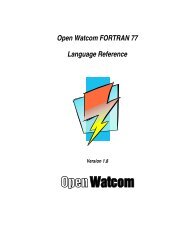Relocatable Object Module Format (OMF) Specification
Relocatable Object Module Format (OMF) Specification
Relocatable Object Module Format (OMF) Specification
You also want an ePaper? Increase the reach of your titles
YUMPU automatically turns print PDFs into web optimized ePapers that Google loves.
<strong>Relocatable</strong> <strong>Object</strong> <strong>Module</strong> <strong>Format</strong><br />
Block Count Field<br />
The Block Count field is a 16-bit word whose value determines the interpretation of the Content field, as follows:<br />
0 Indicates that the Content field that follows is a 1-byte count value followed by count data bytes.<br />
The data bytes will be mapped to memory, repeated as many times as are specified in the<br />
Repeat Count field.<br />
!= 0 Indicates that the Content field that follows is composed of one or more Data Block fields. The<br />
value in the Block Count field specifies the number of Data Block fields (recursive definition).<br />
Notes<br />
The Microsoft C Compiler generates LIDATA records for initialized data. For example:<br />
static int a[100] = { 1, };<br />
A FIXUPP record may occur after the LIDATA record; however, the fixup is applied before the iterated<br />
data block is expanded. It is a translator error for a fixup to reference any of the Count fields.<br />
Example 1<br />
02 00 02 00 03 00 00 00 02 40 41 02 00 00 00 02 50 51<br />
is an iterated data block with 16-bit repeat counts that expands to:<br />
40 41 40 41 40 41 50 51 50 51 40 41 40 41 40 41 50 51 50 51<br />
Here, the outer data block has a repeat count of 2 and a block count of 2 (which means to repeat twice the result<br />
of expanding the two inner data blocks). The first inner data block has repeat count = 3, block count = 0. The<br />
content is 2 bytes of data (40 41); the repeat count expands the data to a string of 6 bytes. The second (and last)<br />
inner data block has a repeat count = 2, block count = 0, content 2 bytes of data (50 51). This expands to 4 bytes,<br />
which is concatenated with the 6 bytes from the first inner data block. The resulting 10 bytes are then expanded<br />
by 2 (the repeat count of the outer data block) to form the 20-byte sequence illustrated.<br />
Example 2<br />
This sample LIDATA record corresponds to the following assembler statement, which declares a 10-element array<br />
containing the strings ALPHA and BETA:<br />
db<br />
10 dup('ALPHA','BETA')<br />
The LIDATA record is<br />
0 1 2 3 4 5 6 7 8 9 A B C D E F<br />
0000 A2 1B 00 01 00 00 0A 00 02 00 01 00 00 00 05 41 ...............A<br />
0010 4C 50 48 41 01 00 00 00 04 42 45 54 41 A9 LPHA.....BETA.<br />
Byte 00H contains 0A2H, identifying this as an LIDATA record.<br />
Bytes 01-02H contain 1BH, the length of the remainder of the record.<br />
Byte 03H (the Segment Index field) contains 01H, a reference to the first SEGDEF record in this object module,<br />
indicating that the data declared in this LIDATA record is to be placed into the segment described by the first<br />
SEGDEF record.<br />
50 <strong>OMF</strong> <strong>Specification</strong>, Version 1.1 Tool Interface Standards (TIS)
















